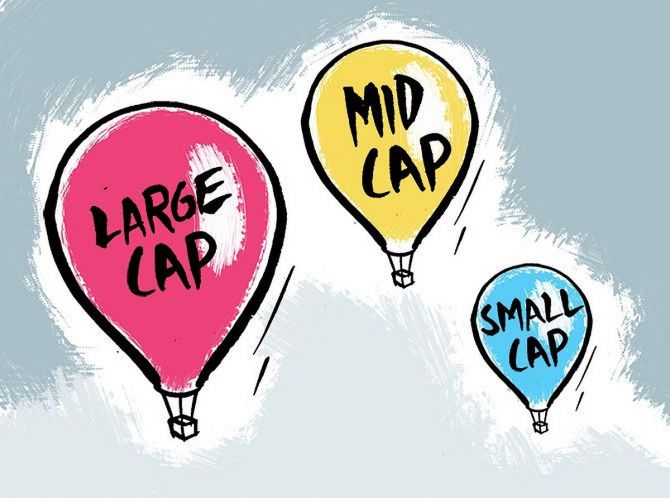The recent circular follows the ‘true-to-label’ concept, but large funds in the multi-cap category may be forced to merge in the absence of sufficient small-cap options.

The Securities and Exchange Board of India’s (Sebi’s) latest circular on the Rs 1.5 trillion multi-cap fund category is likely to lead to another churn in the stock market.
It may give a boost to mid- and small-cap stocks but fund managers will be forced to prune their holdings in large-cap stocks.
The deadline for compliance with the new guidelines - a minimum of 25 per cent each in large-cap, mid-cap and small-cap - is January 31, 2021.
The move, according to industry experts, means around Rs 35,000 crore each will have to be allocated to mid- and small-cap stocks unless schemes decide to merge their multi-cap schemes with large-cap ones or convert their multi-cap schemes to another scheme category, for instance, a large-cum mid-cap scheme — options that were given to fund houses in a clarification by the market regulator.
But the question is what led to this circular.
Experts argue that Sebi’s circular is based on “true-to-label” and “appropriate benchmark” concepts. Said Sandeep Parekh, founder, Finsec Law Advisors: “One can understand Sebi’s logic here because a fund house needs to follow the mandate of the scheme.
"So, a multi-cap scheme should cover stocks of all categories, not just large-cap stocks.
"However, the market regulator should also allow flexi-cap funds that will allow fund houses to tinker with the cap.”
According to data from mutual fund industry sources, many multi-cap schemes have more than over 80 per cent of their holdings in large-cap stocks owing to the safety factor.
Said Nilesh Shah, managing director, Kotak Mutual Fund: “We have to manage funds in the best interest of investors as well as in compliance of not only the letter but also spirit of the law.
"The Street is expecting buying in small-and mid-caps and selling in large-caps by multi-cap funds.”
Sebi’s new guidelines come on the back of its 2018 rules introducing minimum limits for all categories of equity funds.
That is, large-cap funds were asked to have a minimum of 80 per cent of their stocks in large-cap companies or the top 100 companies.
Mid-cap funds were asked to have minimum of 65 per cent in mid-cap stocks (from 101 to the top 250 firms) and multi-cap funds were mandated to keep a minimum of 65 per cent in all equities, and the rest could be invested in other instruments or cash.
Due to this classification in 2018, fund managers repositioned their portfolios, leading to a lot of problems for private portfolio managers.
At that time, south India-based Equity Intelligence founder Porinju Veliyath, who runs a Rs 1,000-crore portfolio management services, had said that the unusual sell-off in non-index stocks, particularly mid- and small-caps, for multiple reasons, including political developments, the banking clean-up and mutual fund restructuring to comply with Sebi’s reclassification norms had hurt his portfolio.
After Sebi’s latest move, he is quite happy.
“Huge positive for investment-worthy small and mid-caps. Fund managers were just throwing them to dustbin since January 2018.
"Valuations of many relevant, futuristic and well managed but ridiculed companies to regain sanity,” he tweeted.
Others such as V K Sharma, head of business (private client group), HDFC Securities, also believes that fund houses should follow these guidelines, but with a caveat.
“They may want to seek a lower percentage for the small caps, to begin with, and reach the desired threshold over a longer time so that justice can be done to the investors’ interests as well as the objective of the market regular to broad-base the markets,” said Sharma.
However, while portfolio managers believe that the position of the market regulator is correct, fund managers think that the timing could have been better.
“While the regulator’s concern is understandable, but given that the economy’s growth has slipped badly and one does not have much visibility especially in case of small-cap stocks, the timing of the move isn’t great,” said a fund manager who requested anonymity.
Another concern is the fact that large-cap stocks, the top-100, contribute 74 per cent of the total market capitalisation, whereas mid- and small-cap stocks contribute 15 per cent and 11 per cent respectively, according to data from Business Standard Research Bureau.
In such circumstances, it is quite difficult for a fund house, especially with a large asset base, to allocate significant amounts to small-cap stocks.
In fact, the total assets under management of all small-cap funds taken together is slightly over Rs 45,000 crore.
Added Shah: “We will ensure full compliance with Sebi regulations as well as optimise risk-adjusted return for our investors.
"We recommend investors to take investment decision based on their risk profile and investment goals.”
For multi-cap funds, especially the big ones with over Rs 10,000 crore in assets under management, this move means that many may have to use the other options given by the market regulator - reclassifying or merging them as large or mid-cap schemes or a combination of both.
The schemes, which have lesser assets, may still be willing to take the bet and move some money to small-cap stocks.
Interesting times for fund managers, especially in times of low visibility on economic growth.











